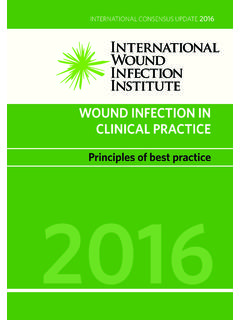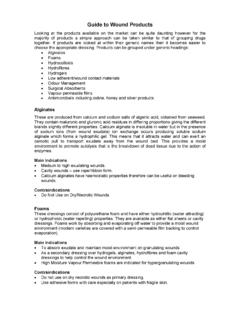Transcription of AS AT Cellulitis and Wound Management
1 8 OSTOMY Wound Management AUGUST FOR PRACTICEThis article was not subject to the Ostomy Wound Management peer-review and Wound ManagementJoanne Martin, RN, BSN, CWOCN Deaconess Home Health Care, Savannah, TN Cellulitis is a fairly common, diffuse, acute infection of the skin and subcutaneous tissue caused by bacteria invad-ing the tissues from a break in the skin. Certain patients, such as persons with diabetes or a weakened immune system, are at greater risk for Cellulitis . Wound care practitioners often see Cellulitis associated with wounds. Cellulitis most often affects the extremities and the face, although it can develop under the skin in any part of the body. It can be life-threatening if unrecognized or un-treated because it can progress to tissue death and systemic sepsis.
2 Therefore, immediate attention and close monitoring are presents as redness, warmth, and edema that can spread rapidly. When Cellulitis is associated with a Wound , it can be identified by red distinct borders, usually 2 cm circumferentially around the Wound , and may have a glossy stretched appearance. Patients often experience ten-derness or pain in the affected tissues. The diagnosis of cel-lulitis is usually based on the patient s history and clinical signs and the Cellulitis is spreading or the case is severe, the pa-tient may need more extensive investigation such as diagnos-tic tests to rule out possible systemic infection. If the Cellulitis worsens after appropriate treatment, a diagnosis of necrotiz-ing fasciitis should be considered.
3 Cellulitis treatment may include antibiotic intervention, pharmaceutical pain Management , bed rest, and elevating the affected area and applying warm soaks to help reduce the inflammatory process and provide pain relief. Appro-priate care should help manage inflammation, swelling, pain, and exudate. nClinician Commentary: PolyMem Dressings Good Versatility, Good Choice As my acute care facility s only CWOCN, I must choose Wound care products that work well for a variety of wounds and are cost-effective. PolyMem provides the absolute optimum environment for healing. Dress-ing changes are quick. The dressing contains a cleanser, so no manual cleansing is needed at dressing changes and the dressing continually cleanses the Wound in-between dressing changes.
4 Because there is glycerin in the dressing, the dressings do not adhere to the Wound bed and therefore minimize pain upon dressing removal. PolyMem never met a Wound it did not like. PolyMem works for nearly any Wound I have treated, including skin tears, pressure ulcers, venous ulcers, dia-betic ulcers, abrasions, and surgical wounds. Recently, I had a 34-year-old patient with Cellulitis of his foot and an abscess of the great toe that required a wide excision and drainage of three areas on his foot. He was neuropathic; thus, he had no sensation of pain. His wounds were healing nicely, but swelling continued in the great toe. The great toe progressed to osteomyelitis and required a second incision at the base of the toe at 10 weeks.
5 The patient was on vancomycin for 12 weeks. Wound care treatment included the use of PolyMem Sil-ver , PolyMem Wic Silver, PolyMem Rope Silver cavity fillers, and nonadhesive PolyMem dressings without sil-ver. When the erythema decreased and the infection was resolving, the patient progressed to pink PolyMem non-adhesive dressings. All PolyMem formulation dressings help reduce the spread of inflammation and swelling into surrounding undamaged tissues without hindering the localized inflammatory response required for healing the injury. PolyMem dressings helped reduce this patient s erythema in the great toe. The wounds completely healed in 12 weeks and his foot was saved.
6 NLora McMichael, RN, BSN, CMSRN, CWOCNW ound/Ostomy Nurse, Major HospitalShelbyville, INShare your Pearls for PracticeIf your Pearl is selected for publication, you will receive cash honoraria or a free copy of Chronic Wound Care IV. Send your Pearls to the Editor: 88/3/11 9:51 AM











